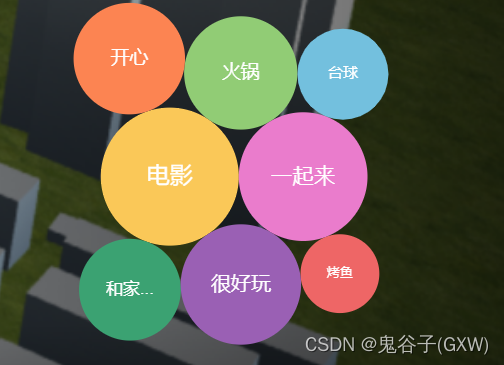我使用d3的原因是要用echarts的热词气泡图
下载
npm install d3 --save-dev
或者
cnpm install d3 --save-dev
引入
import * as d3 from 'd3';//引入d3

<!-- d3js 气泡图 -->
<template>
<div id="bubble" style="width: 500px;height:500px"></div>
</template>
<script>
import * as echarts from 'echarts/core';
import {
DatasetComponent,
TooltipComponent,
VisualMapComponent
} from 'echarts/components';
import { CustomChart } from 'echarts/charts';
import { CanvasRenderer } from 'echarts/renderers';
echarts.use([
DatasetComponent,
TooltipComponent,
VisualMapComponent,
CustomChart,
CanvasRenderer
]);
import * as d3 from 'd3';
export default {
data() {
return {
option: {},
colorList: ['#5470c6', '#91cc75', '#fac858', '#ee6666', '#73c0de', '#3ba272', '#fc8452', '#9a60b4', '#ea7ccc']
};
},
mounted() {
let that = this
let seriesData = [
{
depth: 0,
id: 'option',
index: 0,
value: 0
},
{
depth: 1,
id: 'option.dataZoom',
index: 1,
value: 62
},
{
depth: 1,
id: 'option.哈哈',
index: 2,
value: 92
},
{
depth: 1,
id: 'option.dataZoom-inside',
index: 3,
value: 30
},
{
depth: 1,
id: 'option.dataZoom1',
index: 4,
value: 40
},
{
depth: 1,
id: 'option.dataZoom2',
index: 5,
value: 50
},
{
depth: 1,
id: 'option.dataZoom3',
index: 5,
value: 60
},
{
depth: 1,
id: 'option.dataZoom4',
index: 5,
value: 70
},
{
depth: 1,
id: 'option.dataZoom5',
index: 5,
value: 80
}
];
let displayRoot = stratify1();
function stratify1() {
return d3
.stratify()
.parentId(function (d) {
return d.id.substring(0, d.id.lastIndexOf('.'));
})(seriesData)
.sum(function (d) {
return d.value || 0;
})
.sort(function (a, b) {
return b.value - a.value;
});
}
function overallLayout(params, api) {
let context = params.context;
d3
.pack()
.size([api.getWidth() - 2, api.getHeight() - 2])
.padding(0)(displayRoot);
context.nodes = {};
displayRoot.descendants().forEach(function (node) {
context.nodes[node.id] = node;
});
}
function renderItem(params, api) {
let context = params.context;
let idx = params.dataIndex;
// Only do that layout once in each time `setOption` called.
// 每次调用“setOption”时,只能进行一次布局。
if (!context.layout) {
context.layout = true;
overallLayout(params, api);
}
let nodePath = api.value('id');
let nodeName = nodePath
.slice(nodePath.lastIndexOf('.') + 1)
.split(/(?=[A-Z][^A-Z])/g)
.join('\n')
let node = context.nodes[nodePath];
if (node.id === 'option') {
node.r = 0
}
if (!node) {
// Reder nothing.
return;
}
let z2 = api.value('depth') * 2;
return {
type: 'circle',
shape: {
cx: node.x,
cy: node.y,
r: node.r
},
// transition: ['shape'],
z2: z2,
textContent: {
type: 'text',
style: {
// transition: isLeaf ? 'fontSize' : null,
text: nodeName,
fill: '#fff',
fontFamily: 'Arial',
width: node.r * 1.3,
overflow: 'truncate',
fontSize: node.r / 3
},
emphasis: {
style: {
overflow: null,
fontSize: Math.max(node.r / 3, 12)
}
}
},
textConfig: {
position: 'inside'
},
style: {
fill: that.colorList[idx % that.colorList.length]
},
emphasis: {
style: {
fontFamily: 'Arial',
fontSize: 12,
shadowBlur: 20,
shadowOffsetX: 3,
shadowOffsetY: 5,
shadowColor: 'rgba(0,0,0,0.3)'
}
}
};
}
this.option = {
dataset: {
source: seriesData
},
tooltip: {},
hoverLayerThreshold: Infinity,
series: [{
type: 'custom',
colorBy: 'data',
renderItem: renderItem,
progressive: 0,
coordinateSystem: 'none',
encode: {
tooltip: 'value',
itemName: 'id'
}
}]
}
this.initEcharts()
},
methods: {
initEcharts() {
let myChart = echarts.init(document.getElementById('bubble'))
myChart.setOption(this.option)
}
}
}
</script>





















 1万+
1万+











 被折叠的 条评论
为什么被折叠?
被折叠的 条评论
为什么被折叠?








